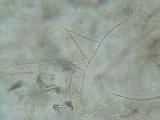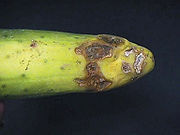
Rhizoctonia solani
Encyclopedia
Rhizoctonia solani is a plant pathogenic fungus with a wide host range and worldwide distribution. This plant pathogen was discovered more than 100 years ago. Rhizoctonia solani frequently exists as thread-like growth on plants or in culture. Asexual spores are not produced, only the sexual stage is known. The Sexual spores are observed on diseased plants, these spores are categorized to make plant pathogen a basidiomycete. Rhizoctonia solani attacks many hosts and produces a variety of symptoms. Rhizoctonia Solani is known to cause serious plant losses by attacking primarily the roots and lower stems of plants and although they have a wide range of host their main targets are herbaceous plants. Disease cycle is important to understand for disease management in certain stages of life.
Sexual spores are formed on basidia. Four spores are produced on each basidium. Each basidiospore has one nucleus, and are formed when the environment is moist. When spores go through anastamosis and fuse, new hyphae with a mixture of different nuclei are formed.
Rhizoctonia solani are saprophytic, soil inhabitants, and feed on dead organic matter.
Rhizoctonia may invade the seed and cause seed decay wile the seed is still in the fruit. This may cause decaying the seed in the fruit or just infecting Damping off of seedlings can occur in the preemergence phase. Bad environmental conditions gives the seedling a higher risk of being infected by Rhizoctonia solani. Postemergence damping off is a further delay in attack of Rhizoctonia solani. The seedling is most susceptible to disease in its juvenile stage.
Cereals in areas of England, South Australia, Canada, and India endure loses caused by Rhizoctonia solani. Roots are killed back and brown stumps, causing plants to be stunted and spindly. In England, this is called purple patch. Rhizoctonia solani also can cause hypocotyl and stem cankers on mature plants of tomatoes and cabbage. Strands of mycelium and sometimes sclerotia appaear on their surfaces. Roots will turn brown and die after a period of time. The best known symptom of Rhizoctonia solani is the black sclerotia on potato tubers.
Host range of the fungus is very wide. Strains of Rhizoctonia solani may differ in: the hosts they are able to attack, the virulence of attack, ranging for a given host from nonpathogenic to highly virulent, the temperature at which the attack will occur, the ability to develop in lower soil levels, the ability to form sclerotia, the growth rate, the survival in a certain area. These factors may or may not show up given the environment and host that Rhizoctonia attacks.
 Rhizoctonia solani does not produce spores and is hence identified only from mycelial characteristics or DNA analysis. Its hyphal cells are multinucleate
Rhizoctonia solani does not produce spores and is hence identified only from mycelial characteristics or DNA analysis. Its hyphal cells are multinucleate
. It produces white to deep brown mycelium when grown on artificial medium. The hyphae are 4–15 μm wide and tend to branch at right angles. A septum near each hyphal branch and a slight constriction at the branch are diagnostic. R. solani is subdivided into anastomosis groups (AG) based on hyphal fusion between compatible strains.
The teleomorph of R. solani is Thanatephorus cucumeris. It forms club-shaped basidia
with four apical sterigmata on which oval, hyaline basidiospores are borne.
Importance and History
In 1858, Julius Kuhn observed a fungus on diseased potato tubers and named in Rhizoctonia solani. This is a widespread, destructive, and versatile plant pathogen. The fungi occurs in all parts of the world, and is capable of attacking many different host plants, causing seed decay, damping-off, stem cankers, fruit decay, and foliage diseases.Biology
Rhizoctonia solani produces hyphae in large masses called mycelium. Due to the production of mycelium these soil inhabiting pathogens are referred to as "sterile fungi". The mycelial cells of this species contain many nuclei whereas other rhizoctonia pathogens only have 2 nuclei per mycelium. The hyphae have characteristics of: shades of brown, cross walls, multinucleate cells, branches produced at right angles, and no asexual spores. When grown in culture, the growth rate of Rhizoctonia solani is very fast. Small, oval cells are produced in branched chains. They have thick walls and sclerotia 3 to 5 mm long can be seen. This species is thought of as a "collective" species since it consists of several more or less unrelated strains. An important characteristic of rhizoctonia solani is their abilitiy to perform anastomosis(hyphal fusion) which only occur between isolates of the same group. There are 4 main anastomosis isolated groups that are known to this day, and these are important to classify for innoculating/in breeding crops for resistance to the pathogen. Each group is described/classified by the symptoms it causes on its hosts. Example- AG1-all isoltates cause seed and hypocotyl rot/ aerial blights. AG2-canker of root crops, wire stem on crucifers and brown patches on turf.Sexual spores are formed on basidia. Four spores are produced on each basidium. Each basidiospore has one nucleus, and are formed when the environment is moist. When spores go through anastamosis and fuse, new hyphae with a mixture of different nuclei are formed.
Rhizoctonia solani are saprophytic, soil inhabitants, and feed on dead organic matter.
Hosts and Symptoms
Rhizoctonia solani primarily attacks below ground seeds and roots of plants, but can also infect pods, roots, leaves and stems. The most common symptom of Rhizoctonia is "damping off", or non germination of infected seeds. Damping off is the decay of the stem at about soil level, causing the plant to fall over because it does not have thick enough supporting tissue. Root rot is also an important symptom of Rhizoctonia solani. Seeds that do germinate before being killed by the fungus have reddish-brown lesions and cankers on stems and roots.Rhizoctonia may invade the seed and cause seed decay wile the seed is still in the fruit. This may cause decaying the seed in the fruit or just infecting Damping off of seedlings can occur in the preemergence phase. Bad environmental conditions gives the seedling a higher risk of being infected by Rhizoctonia solani. Postemergence damping off is a further delay in attack of Rhizoctonia solani. The seedling is most susceptible to disease in its juvenile stage.
Cereals in areas of England, South Australia, Canada, and India endure loses caused by Rhizoctonia solani. Roots are killed back and brown stumps, causing plants to be stunted and spindly. In England, this is called purple patch. Rhizoctonia solani also can cause hypocotyl and stem cankers on mature plants of tomatoes and cabbage. Strands of mycelium and sometimes sclerotia appaear on their surfaces. Roots will turn brown and die after a period of time. The best known symptom of Rhizoctonia solani is the black sclerotia on potato tubers.
Host range of the fungus is very wide. Strains of Rhizoctonia solani may differ in: the hosts they are able to attack, the virulence of attack, ranging for a given host from nonpathogenic to highly virulent, the temperature at which the attack will occur, the ability to develop in lower soil levels, the ability to form sclerotia, the growth rate, the survival in a certain area. These factors may or may not show up given the environment and host that Rhizoctonia attacks.
Disease Cycle
Rhizoctonia solani can survive many years in sclerotia in soil and plant tissue. Sclerotia with thick outer layers allow for survival and these sclerotia act as the overwintering spore for the pathogen. This plant pathogen also survives as mycelium in organic matter. The fungus is attracted to the plant by chemical stimuli released by a growing plant and/or decomposing plant reisude. The process of penetration of a host can be accomplished in a number of ways. Entry can occur through the cuticle and epidermis, or through natural openings of the plant. Hyphae will come in contact with the plant and attach to the plant. The fungus continues to grow and produces an appresorium that penetrates the plant cell and allows for the pathogen to get nutrients from the plant, also using hyphae to go into the plant cells. The pathogen also releases enzymes that breaks down plant cell walls, and continues to colonize and grow inside dead tissue. This forms sclerotia. New inoculum is produced on or in the host tissue, and a new cycle is repeated when new plants become available.Identification

Multinucleate
Multinucleate cells have more than one nucleus per cell, which is the result of nuclear division not being followed by cytokinesis. As a consequence, multiple nuclei share one common cytoplasm. This can be the consequence of a disturbed cell cycle control Multinucleate (also multinucleated,...
. It produces white to deep brown mycelium when grown on artificial medium. The hyphae are 4–15 μm wide and tend to branch at right angles. A septum near each hyphal branch and a slight constriction at the branch are diagnostic. R. solani is subdivided into anastomosis groups (AG) based on hyphal fusion between compatible strains.
The teleomorph of R. solani is Thanatephorus cucumeris. It forms club-shaped basidia
Basidium
thumb|right|500px|Schematic showing a basidiomycete mushroom, gill structure, and spore-bearing basidia on the gill margins.A basidium is a microscopic, spore-producing structure found on the hymenophore of fruiting bodies of basidiomycete fungi. The presence of basidia is one of the main...
with four apical sterigmata on which oval, hyaline basidiospores are borne.

